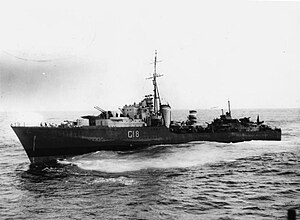 Zulu
| |
| History | |
|---|---|
| Name | Zulu |
| Namesake | Zulu people |
| Ordered | 10 March 1936 |
| Builder | Alexander Stephen and Sons, Linthouse |
| Cost | £351,135 |
| Laid down | 27 August 1936 |
| Launched | 23 September 1937 |
| Completed | 6 September 1938 |
| Identification | Pennant numbers: L18, later F18 |
| Fate | Sunk by aircraft, 14 September 1942 |
| Badge | On a Field Barry, wavy of six white and blue; in front of two Zulu spears in saltire surmounted a Zulu shield all proper |
| General characteristics (as built) | |
| Class and type | Tribal-class destroyer |
| Displacement | |
| Length | 377 ft (114.9 m) (o/a) |
| Beam | 36 ft 6 in (11.13 m) |
| Draught | 11 ft 3 in (3.43 m) |
| Installed power |
|
| Propulsion | 2 × shafts; 2 × geared steam turbines |
| Speed | 36 knots (67 km/h; 41 mph) |
| Range | 5,700 nmi (10,600 km; 6,600 mi) at 15 knots (28 km/h; 17 mph) |
| Complement | 190 |
| Sensors and processing systems | ASDIC |
| Armament |
|
HMS Zulu was a Tribal-class destroyer of the Royal Navy and the second ship to bear the name. Built in Glasgow by Alexander Stephen and Sons, her keel was laid down on 10 August 1936, she was launched on 23 September 1937 and commissioned on 7 September 1938.
Zulu was sunk by German or Italian aircraft on 14 September 1942, off Tobruk.[1] Some sources credit Junkers Ju 87 "Stuka" dive bombers from StG 3 with her sinking, [2][3] but the ship's commanding officer testified she was sunk by a combination of Ju 87s and Junkers Ju 88s.[4]
- ^ Rohwer 2005, p. 196.
- ^ de Zeng, Stankey & Creek 2009, p. 109.
- ^ Weal 1998, p. 65.
- ^ Smith 2008, pp. 188–189.